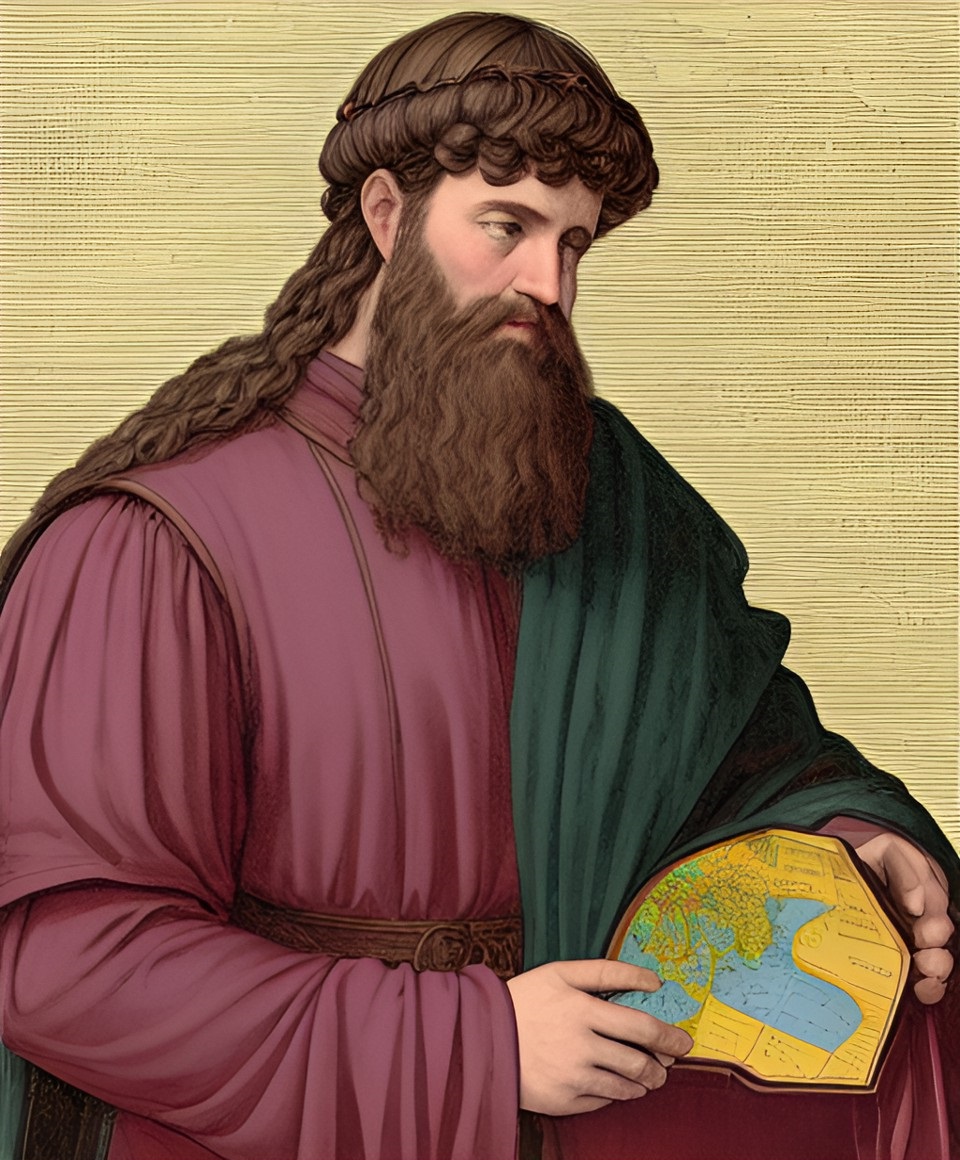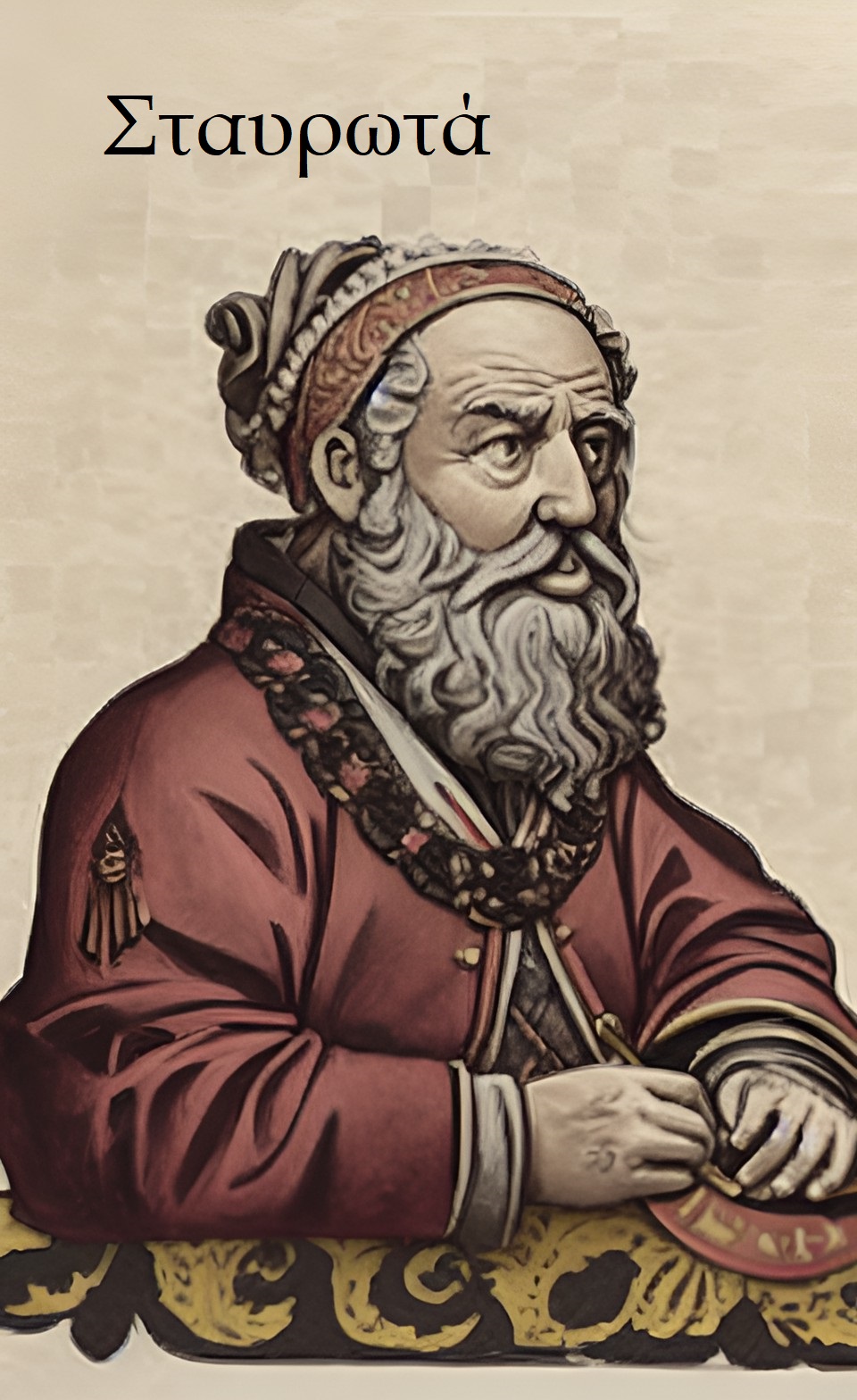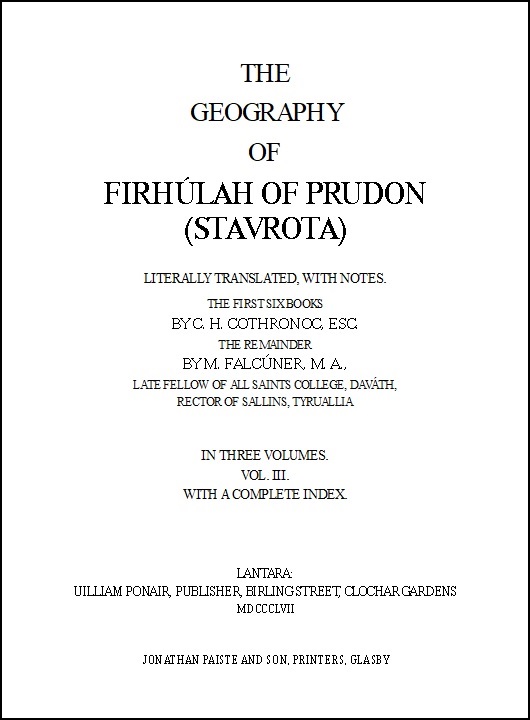Firhúlah of Prudon (Stavrota)
Firhúlah of Prudon (/ˌfɪɹ 'huː lə/; c. 60 BCS – c. 24 CA), also known as Stavrota, was an ancient Raionian geographer, historian and philosopher who lived in Pithicasia and Érevon during the Mílesian Age. By his own accounts, he traveled prodigiously throughout his lifetime. His journeys brought him to such far-flung destinations as the Neanderlands in the North, Salizia, Nolveria and Gog in the West, Cyrontia and No'Am in the East, and even Jenubia in the South.
He is known for his only surviving work, the Geográfaíocht (“Geography”), written between 7 and 22 CA. It is the only extant geographical composition from the time, providing an encyclopædic description of all the nations of the known world during the reign of Mílesian Emperor Garbhán II. In it, he proudly boasted that no geographer before him had ever traveled the world as broadly as he had.
Of all the writers who have ever treated upon the subject of geography in the past, none can be named who has travelled over a wider extent of the world than we. Some may have gone farther to the west, but then they have never been so far east as we; again, others may have been farther east, but not so far west; and the same with respect to the north and the south.
--Firhúlah of Prudon, Geográfaíocht
Unfortunately for modern scholars, his earlier forty-three volume opus, the Histáiraíocht (“History”), which carried forward the earlier historical compilations of Mórnabrah, has long been lost, along with several of his other literary works.
Early Life
Virtually all that is known about Firhúlah of Prudon is derived from his own descriptions contained in his writings, as very few other contemporaneous references to his life and work have survived. His name, Firhúlah, meaning “squint-eyed,” is not a common one, and may have been a nickname given to him by the Érevish in Lantara. If so, his actual given name remains unknown.He was born in the village of Prudon, outside of Gohreen in Ocranta, Pithicasia, and spent his early childhood there. As he himself tells it, the date of his birth was shortly before the death of Emperor Laserian the Great, who died in 60 BCS. He describes his mother’s family in great detail as very well connected and prosperous, but remains utterly silent about his father or his paternal ancestors.
While still a young boy, Firhúla embarked upon his first journey when his family was displaced by the Mílesian suppression of the Pithicasians in 51 BCS, and forced to emigrate south to the land of the Erdini. It was there that he took up the study of grammar and rhetoric under the Cyrontian master Amalamis at Coláiste in Orefni, an important religions and cultural center north of Erpeditan. He would later continue his studies under renowned philosopher Lewys of Mersinia, after relocating to Lantara in 44 BCS, where he remained as a scholar until at least 31 BCS. Most historians believe he wrote the greater portion of his “History” during that time.
During his lifetime, travel for scholarly purposes was increasingly popular, enabled, if not encouraged, by the relative peace and prosperity that endured throughout the Mílesian Empire during the reigns of Emperor Daghán III (60-29 BCS) and his sons, Lughán IV (29-16 BCS) and Thóm (16-3 BCS). Nevertheless, most scholars consider remarkable the extent to which Firhúlah availed himself of the opportunities.
Travels
In 29 BCS, Firhúlah returned to Pithicasia, to visit his birthplace, later continuing northward into the Neanderland on a journey of exploration that took him as far as Arkkukari on the shores of Lake Gyalwa. He was among the very first western writers to describe the habits and customs exhibited by the Cynids of the North.In 25 or 24, he crossed the Halbergen Mountains into Jarmenia, continuing west to the headwaters of the Ganfel River, now called the Pflegan, which he traveled for its entire length to its mouth on the Salizean Sea. Before returning to Lantara in 21 BCS, he also visited the Nolverian Peninsula and sailed up the Radegundis River into the land of the Gog.
He is known to have visited Lower and Upper Cyrontia sometime after 15 BCS, and to have crossed the Cyrontial Mountains into No'Am, where, it is believed, he was granted an audience with Aidasgü, the Great Gahn of No'Am himself. Most scholars believe it was on this expedition that he was given the name “Stavrota,” most likely during his visit to Chök'Yi, as it is similar to a Cyrontian word for "squint."
In 7 BCS, Firhúlah sailed south across the Torrean Sea to the ancient city of Himodes in Betenia. From there he spent the next four years traveling extensively throughout Jenubia, visiting Adatenesis and even, it is reported, the Lost City of Sabhadiq, which he called Margaˈmór (“Great Market”).
The Geography
Firhúlah’s most famous work is without a doubt his Geográfaíocht, which he wrote throughout the latter part of his life. First published as a single volume in 10 CA, it was continually revised and expanded until the final complete version was published in 22 CA. It is from the final publication date that scholars calculate the approximate date of his death.The Geography was apparently not seen as an extraordinary work by contemporary historians and geographers of the time, as it is hardly cited at all in any subsequent works. Nevertheless, several copies survived into the Savage Age. Around 1469, an Érevish translation appeared, giving rise to a resurgence in popularity among scholars.
Since that time, the Geography has been universally praised as a valuable source of information about the ancient world of Firhúla’s time, due primarily to the unique descriptive approach with which he laid out his narration, but also by virtue of the incredible volume of detailed information contained within its many pages.
Firhúlah of Prudon
ΣταυρωτάANCIENT POLYMATH
From the Naourissa Chronicle (1493)
The Geográfaíocht
Title Page of the 1857 Cothronoc and Falcúner Translation
The Geográfaíocht
Title Page of the 1857 Cothronoc and Falcúner Translation





Comments